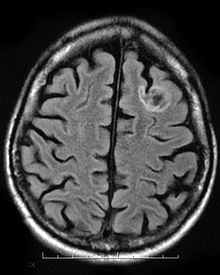Neuroepithelial cell
To make this change, neuroepithelial cells begin to downregulate their epithelial features, by stopping the expression of occludin, a tight junction protein.[4] In the adult CNS, neuroepithelial cells arise in several different areas of the brain: the subventricular zone (SVZ), the olfactory bulb and the dentate gyrus of the hippocampus.[5] On a whole, neurogenesis is regulated both by many varied regulatory pathways in the CNS as well as several other factors, from genes to external stimuli such as the individual behavior of a person.[7] Individuals with these diseases also often express diminished olfactory abilities as well as decreased cognitive activity in the hippocampus, areas specific to neurogenesis.The genes associated with these diseases like α-synuclein, presenilin 1, MAPT (microtubule associated protein tau) and huntingtin are also often associated with plasticity in the brain and its modification.This also leads to many controversial concepts, like neurogenic therapy involving the transplant of local progenitor cells to a damaged area.The cysts occur in the epithelium putting their patients at risk for obstructive hydrocephalus, increased intracranial pressure, and rarely intracystic hemorrhage.While the exact factors that lead to differentiation are unknown, researchers have taken advantage of human-rat neural chimeras to explore the development of human neurons and glial cells in an animal model.These neural chimeras have permitted researchers to look at neurological diseases in an animal model where traumatic and reactive changes can be controlled.Eventually researchers hope to be able to use the information taken from these neural chimera experiments to repair regions of the brain affected by central nervous system disorders.This connection led researches to postulate that depression could be the result of changes in levels of neurogenesis in the adult brain, specifically in the dentate gyrus.



neural tubeembryonic developmentlumenaljunctional complexespseudostratifiedepitheliumstem cellscentral nervous systemneural stem cellsprogenitor cellsradial glial cellsdifferentiateneuronsneurogenesisembryonic growthmorphogenesisectodermneural plateprominin-1tight junctionsIntegrin alpha 6basal laminapseudostratified epithelial cellsforebrainmidbrainhindbrainspinal cordgliogenesiscell nucleusS phaseG2 phasemicrotubulesactin filamentsoccludinneuroblaststight junctionN-cadherinsubventricular zoneolfactory bulbdentate gyrushippocampusperipheral nervous systemmultipotentpluripotentasymmetric cell divisionmitotic spindleciliary neurotrophic factorcytokinesneuregulin 1Huntington's diseaseAlzheimer's diseaseParkinson's diseaseα-synucleinpresenilin 1huntingtinNeuroplasticitydysembryoplastic neuroepithelial tumorbenign tumorseizuresinvasive surgerycolloid cyststhird ventriclehydrocephalusintracranial pressureOligodendroglial tumorsoligodendrocytescerebrumfrontaltemporalanaplasticoligodendrogliomacerebral spinal fluidchimerasembryonic stem cellsintermediate filamentmultiple sclerosisdepressionserotoninList of human cell types derived from the germ layersMedical Subject HeadingsAdult stem cellsCancer stem cellsInduced pluripotent stem cellsCell potencyZygoteMorulaEmbryonic stem cellCallusProgenitor cellEndothelial stem cellHematopoietic stem cellMesenchymal stem cellNeural stem cellPrecursor cellCellular differentiationStem cell therapyStem cell controversyStem cell lineStem cell lawsStem cell laws and policy in the United StatesEpigenetics in stem cell differentiationnervous systemNeural developmentNeurulationNeurulaNotochordNeuroectodermNeural foldNeural grooveNeuropoiesisAdult neurogenesisNeural crestCranial neural crestCardiac neural crest complexTruncal neural crestRostral neuroporeNeuromereRhombomereCephalic flexureCervical flexurePontine flexureAlar plateBasal plateGlioblastNeuroblastGerminal matrix